seats SUBARU IMPREZA WRX 2006 2.G Owners Manual
[x] Cancel search | Manufacturer: SUBARU, Model Year: 2006, Model line: IMPREZA WRX, Model: SUBARU IMPREZA WRX 2006 2.GPages: 365, PDF Size: 7.09 MB
Page 28 of 365

1
Seat, seatbelt and SRS airbags
Front seats .......................................................... 1-2
Fore and aft adjustment ........................... .............. 1-3
Reclining the seatback ............................ ............... 1-3
Seat cushion height adjustment (driver s seat) ... 1-4
Head restraint adjustment (if equipped) ........... .... 1-4
Active head restraint (if equipped) ............... ......... 1-4
Seat heater (if equipped) ......................... .......... 1-5
Rear seats ........................................ ................... 1-6
Armrest (if equipped) ............................. ................ 1-7
Head restraint adjustment Wagon ..................... 1-7
Folding down the rear seat Wagon .................... 1-8
Seatbelts ......................................... .................... 1-9
Seatbelt safety tips .............................. ................... 1-9
Emergency Locking Retractor (ELR) ................. ... 1-11
Automatic/Emergency Locking Retractor
(A/ELR) ........................................... ....................... 1-11
Seatbelt warning light and chime .................. ........ 1-11
Fastening the seatbelt ............................ ................ 1-12
Seatbelt maintenance .............................. ............... 1-18
Seatbelt extender ................................. .............. 1-19
Front seatbelt pretensioners ...................... ....... 1-20
System monitors ................................... ................. 1-21
System servicing .................................. .................. 1-22
Precautions against vehicle modification .......... .. 1-22
Child restraint systems ........................... .......... 1-23
Where to place a child restraint system ........... .... 1-24
Choosing a child restraint system ................. ....... 1-25
Installing child restraint systems with A/ELR seatbelt .......................................... ........................ 1-26Installing a booster seat .........................
................ 1-29
Installation of child restraint systems by use of lower and tether anchorages (LATCH) ............... 1-30
Top tether anchorages ............................. .............. 1-33
*SRS airbag (Supplemental Restraint System airbag) ........................................... ................... 1-35
Vehicle with driver s and front passenger s SRS
airbags and lap/shoulder restraints ............... .... 1-35
Subaru advanced frontal airbag system ............. . 1-39
SRS side airbag ................................... ................... 1-51
SRS airbag system monitors ........................ ......... 1-56
SRS airbag system servicing ....................... ......... 1-57
Precautions against vehicle modification .......... .. 1-58
Page 29 of 365
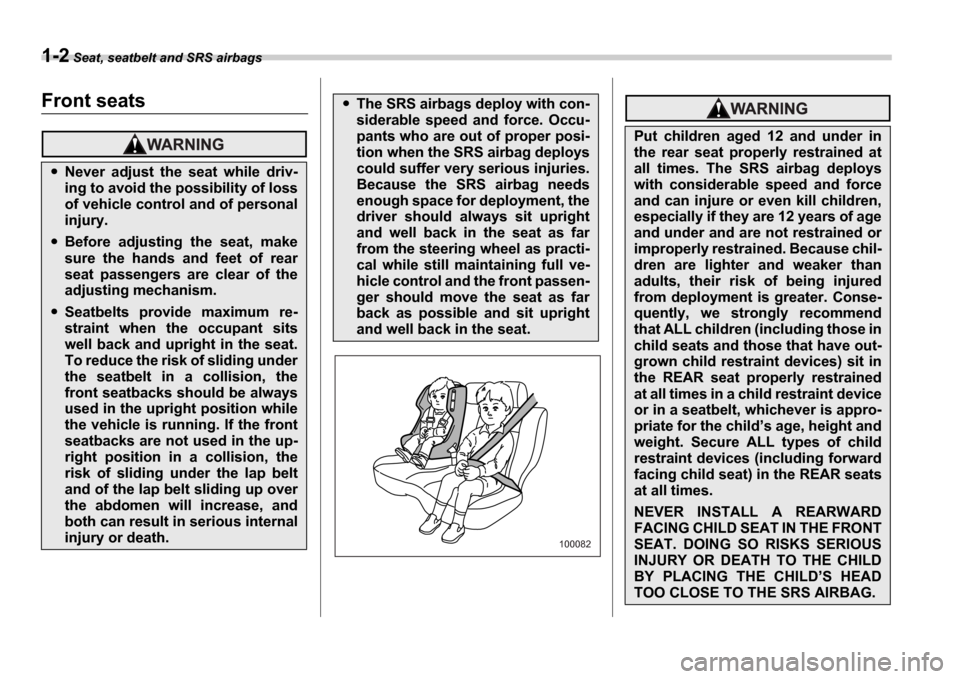
1-2 Seat, seatbelt and SRS airbags
Seat, seatbelt and SRS airbagsFront seats
Never adjust the seat while driv-
ing to avoid the possibility of loss
of vehicle control and of personal
injury.
Before adjusting the seat, make
sure the hands and feet of rear
seat passengers are clear of the
adjusting mechanism.
Seatbelts provide maximum re-
straint when the occupant sits
well back and upright in the seat.
To reduce the risk of sliding under
the seatbelt in a collision, the
front seatbacks should be always
used in the upright position while
the vehicle is running. If the front
seatbacks are not used in the up-
right position in a collision, the
risk of sliding under the lap belt
and of the lap belt sliding up over
the abdomen will increase, and
both can result in serious internal
injury or death.
The SRS airbags deploy with con-
siderable speed and force. Occu-
pants who are out of proper posi-
tion when the SRS airbag deploys
could suffer very serious injuries.
Because the SRS airbag needs
enough space for deployment, the
driver should always sit upright
and well back in the seat as far
from the steering wheel as practi-
cal while still maintaining full ve-
hicle control and the front passen-
ger should move the seat as far
back as possible and sit upright
and well back in the seat.
100082
Put children aged 12 and under in
the rear seat properly restrained at
all times. The SRS airbag deploys
with considerable speed and force
and can injure or even kill children,
especially if they are 12 years of age
and under and are not restrained or
improperly restrained. Because chil-
dren are lighter and weaker than
adults, their risk of being injured
from deployment is greater. Conse-
quently, we strongly recommend
that ALL children (including those in
child seats and those that have out-
grown child restraint devices) sit in
the REAR seat properly restrained
at all times in a child restraint device
or in a seatbelt, whichever is appro-
priate for the child s age, height and
weight. Secure ALL types of child
restraint devices (including forward
facing child seat) in the REAR seats
at all times.
NEVER INSTALL A REARWARD
FACING CHILD SEAT IN THE FRONT
SEAT. DOING SO RISKS SERIOUS
INJURY OR DEATH TO THE CHILD
BY PLACING THE CHILD S HEAD
TOO CLOSE TO THE SRS AIRBAG.
Page 31 of 365
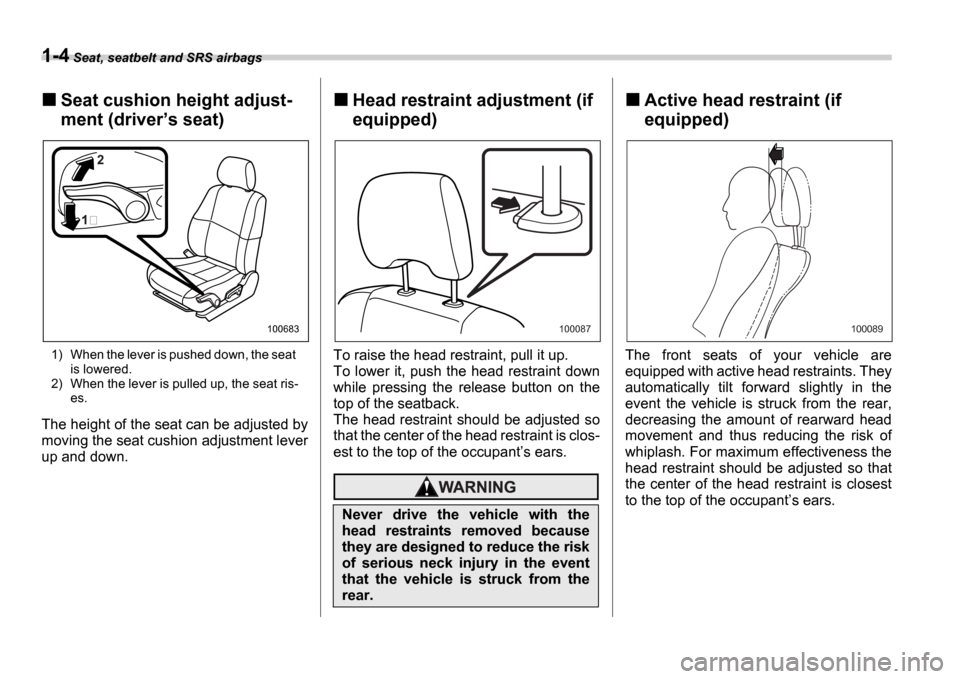
1-4 Seat, seatbelt and SRS airbags
Seat cushion height adjust-
ment (driver s seat)
1) When the lever is pushed down, the seat is lowered.
2) When the lever is pulled up, the seat ris- es.
The height of the seat can be adjusted by
moving the seat cushion adjustment lever
up and down.
Head restraint adjustment (if
equipped)
To raise the head restraint, pull it up.
To lower it, push the head restraint down
while pressing the release button on the
top of the seatback.
The head restraint should be adjusted so
that the center of the head restraint is clos-
est to the top of the occupant s ears.
Active head restraint (if
equipped)
The front seats of your vehicle are
equipped with active head restraints. They
automatically tilt forward slightly in the
event the vehicle is struck from the rear,
decreasing the amount of rearward head
movement and thus reducing the risk of
whiplash. For maximum effectiveness the
head restraint should be adjusted so that
the center of the head restraint is closest
to the top of the occupant s ears.
2
100683
Never drive the vehicle with the
head restraints removed because
they are designed to reduce the risk
of serious neck injury in the event
that the vehicle is struck from the
rear.
100087100089
Page 33 of 365
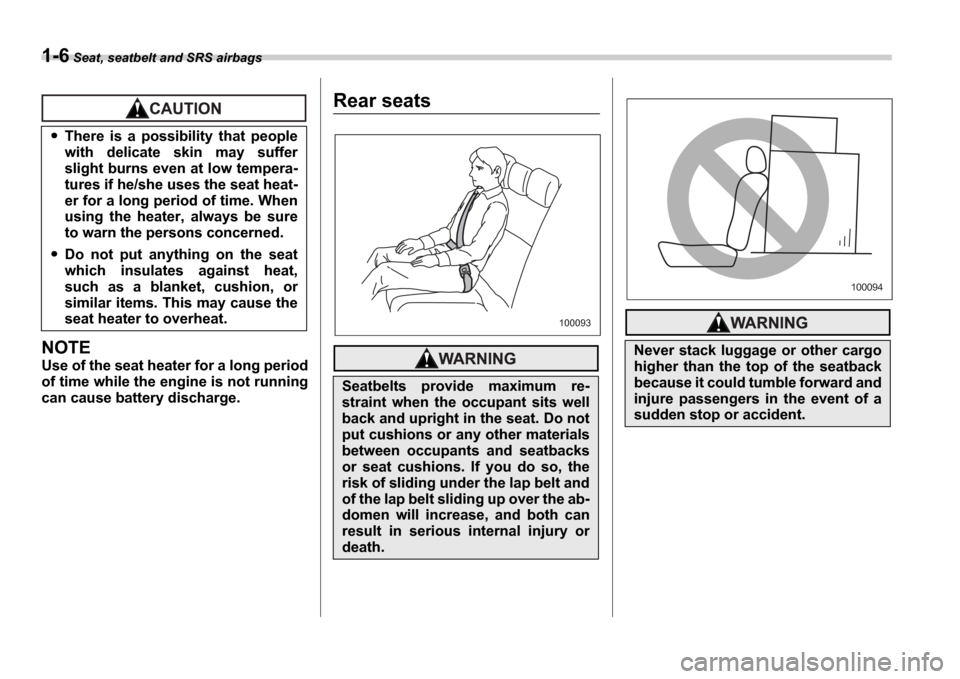
1-6 Seat, seatbelt and SRS airbags
NOTE
Use of the seat heater for a long period
of time while the engine is not running
can cause battery discharge.
Rear seats
There is a possibility that people
with delicate skin may suffer
slight burns even at low tempera-
tures if he/she uses the seat heat-
er for a long period of time. When
using the heater, always be sure
to warn the persons concerned.
Do not put anything on the seat
which insulates against heat,
such as a blanket, cushion, or
similar items. This may cause the
seat heater to overheat.
Seatbelts provide maximum re-
straint when the occupant sits well
back and upright in the seat. Do not
put cushions or any other materials
between occupants and seatbacks
or seat cushions. If you do so, the
risk of sliding under the lap belt and
of the lap belt sliding up over the ab-
domen will increase, and both can
result in serious internal injury or
death.
100093
Never stack luggage or other cargo
higher than the top of the seatback
because it could tumble forward and
injure passengers in the event of a
sudden stop or accident.
100094
Page 35 of 365
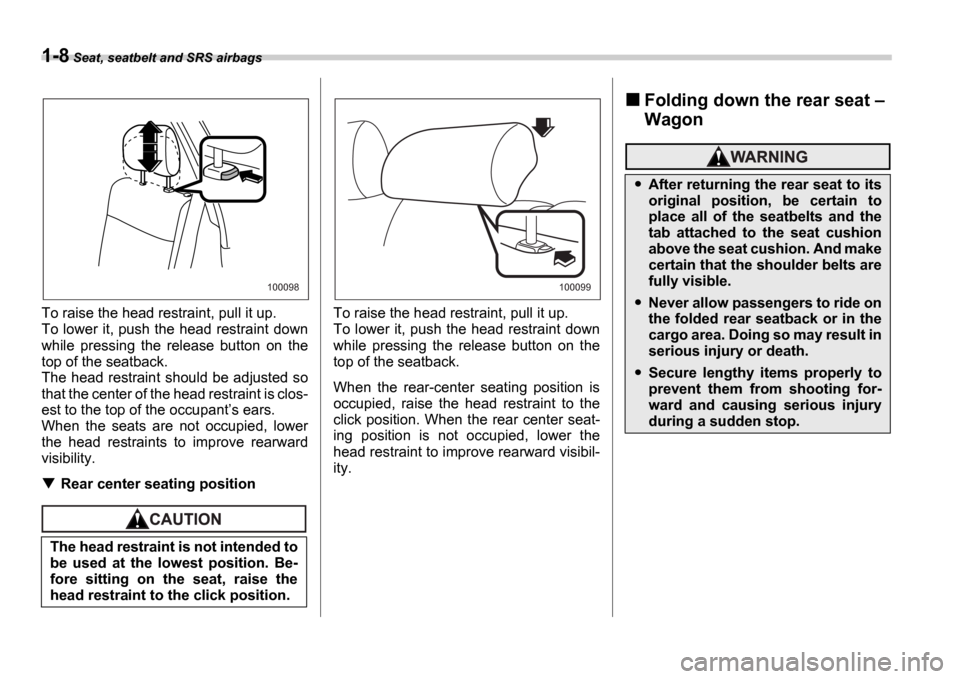
1-8 Seat, seatbelt and SRS airbags
To raise the head restraint, pull it up.
To lower it, push the head restraint down
while pressing the release button on the
top of the seatback.
The head restraint should be adjusted so
that the center of the head restraint is clos-
est to the top of the occupant s ears.
When the seats are not occupied, lower
the head restraints to improve rearward
visibility.
Rear center seating position
To raise the head restraint, pull it up.
To lower it, push the head restraint down
while pressing the release button on the
top of the seatback.
When the rear-center seating position is
occupied, raise the head restraint to the
click position. When the rear center seat-
ing position is not occupied, lower the
head restraint to improve rearward visibil-
ity.
Folding down the rear seat
Wagon
The head restraint is not intended to
be used at the lowest position. Be-
fore sitting on the seat, raise the
head restraint to the click position.
100098100099
After returning the rear seat to its
original position, be certain to
place all of the seatbelts and the
tab attached to the seat cushion
above the seat cushion. And make
certain that the shoulder belts are
fully visible.
Never allow passengers to ride on
the folded rear seatback or in the
cargo area. Doing so may result in
serious injury or death.
Secure lengthy items properly to
prevent them from shooting for-
ward and causing serious injury
during a sudden stop.
Page 37 of 365
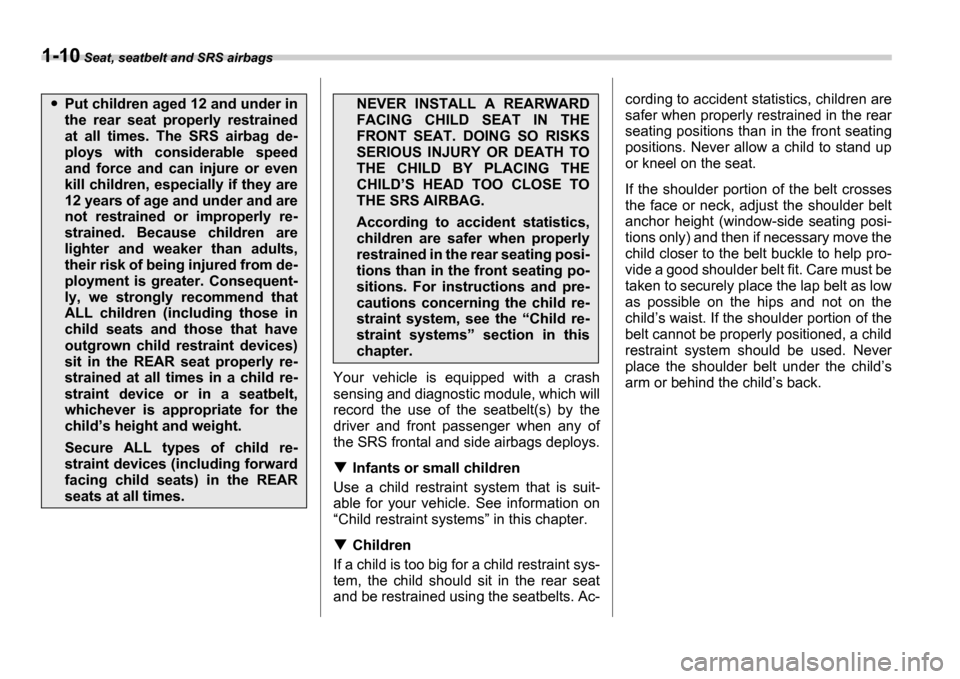
1-10 Seat, seatbelt and SRS airbags
Your vehicle is equipped with a crash
sensing and diagnostic module, which will
record the use of the seatbelt(s) by the
driver and front passenger when any of
the SRS frontal and side airbags deploys.
Infants or small children
Use a child restraint system that is suit-
able for your vehicle. See information on Child restraint systems in this chapter.
Children
If a child is too big for a child restraint sys-
tem, the child should sit in the rear seat
and be restrained using the seatbelts. Ac- cording to accident statistics, children are
safer when properly restrained in the rear
seating positions than in the front seating
positions. Never allow a child to stand up
or kneel on the seat.
If the shoulder portion of the belt crosses
the face or neck, adjust the shoulder belt
anchor height (window-side seating posi-
tions only) and then if necessary move the
child closer to the belt buckle to help pro-
vide a good shoulder belt fit. Care must be
taken to securely place the lap belt as low
as possible on the hips and not on the
child
s waist. If the shoulder portion of the
belt cannot be properly positioned, a child
restraint system should be used. Never
place the shoulder belt under the child s
arm or behind the child s back.
Put children aged 12 and under in
the rear seat properly restrained
at all times. The SRS airbag de-
ploys with considerable speed
and force and can injure or even
kill children, especially if they are
12 years of age and under and are
not restrained or improperly re-
strained. Because children are
lighter and weaker than adults,
their risk of being injured from de-
ployment is greater. Consequent-
ly, we strongly recommend that
ALL children (including those in
child seats and those that have
outgrown child restraint devices)
sit in the REAR seat properly re-
strained at all times in a child re-
straint device or in a seatbelt,
whichever is appropriate for the
child s height and weight.
Secure ALL types of child re-
straint devices (including forward
facing child seats) in the REAR
seats at all times.
NEVER INSTALL A REARWARD
FACING CHILD SEAT IN THE
FRONT SEAT. DOING SO RISKS
SERIOUS INJURY OR DEATH TO
THE CHILD BY PLACING THE
CHILD S HEAD TOO CLOSE TO
THE SRS AIRBAG.
According to accident statistics,
children are safer when properly
restrained in the rear seating posi-
tions than in the front seating po-
sitions. For instructions and pre-
cautions concerning the child re-
straint system, see the Child re-
straint systems section in this
chapter.
Page 38 of 365
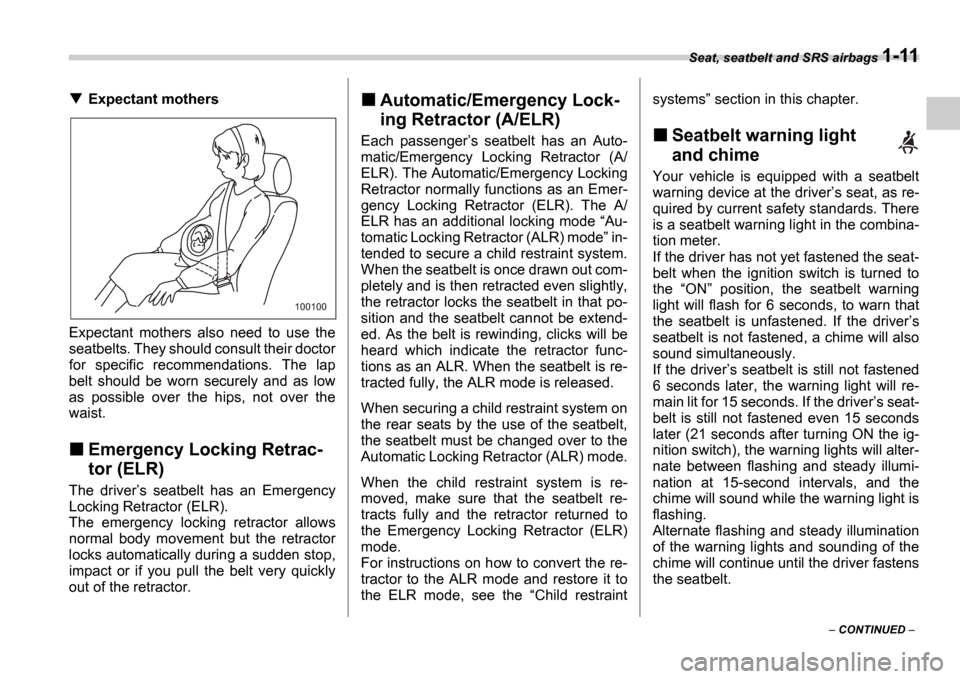
Seat, seatbelt and SRS airbags 1-11
CONTINUED
Expectant mothers
Expectant mothers also need to use the
seatbelts. They should consult their doctor
for specific recommendations. The lap
belt should be worn securely and as low
as possible over the hips, not over the
waist.
Emergency Locking Retrac-
tor (ELR)
The driver s seatbelt has an Emergency
Locking Retractor (ELR).
The emergency locking retractor allows
normal body movement but the retractor
locks automatically during a sudden stop,
impact or if you pull the belt very quickly
out of the retractor.
Automatic/Emergency Lock-
ing Retractor (A/ELR)
Each passenger s seatbelt has an Auto-
matic/Emergency Locking Retractor (A/
ELR). The Automatic/Emergency Locking
Retractor normally functions as an Emer-
gency Locking Retractor (ELR). The A/
ELR has an additional locking mode Au-
tomatic Locking Retractor (ALR) mode in-
tended to secure a child restraint system.
When the seatbelt is once drawn out com-
pletely and is then retracted even slightly,
the retractor locks the seatbelt in that po-
sition and the seatbelt cannot be extend-
ed. As the belt is rewinding, clicks will be
heard which indicate the retractor func-
tions as an ALR. When the seatbelt is re-
tracted fully, the ALR mode is released.
When securing a child restraint system on
the rear seats by the use of the seatbelt,
the seatbelt must be changed over to the
Automatic Locking Retractor (ALR) mode.
When the child restraint system is re-
moved, make sure that the seatbelt re-
tracts fully and the retractor returned to
the Emergency Locking Retractor (ELR)
mode.
For instructions on how to convert the re-
tractor to the ALR mode and restore it to
the ELR mode, see the Child restraint systems
section in this chapter.Seatbelt warning light
and chime
Your vehicle is equipped with a seatbelt
warning device at the driver s seat, as re-
quired by current safety standards. There
is a seatbelt warning light in the combina-
tion meter.
If the driver has not yet fastened the seat-
belt when the ignition switch is turned to
the ON position, the seatbelt warning
light will flash for 6 seconds, to warn that
the seatbelt is unfastened. If the driver s
seatbelt is not fastened, a chime will also
sound simultaneously.
If the driver s seatbelt is still not fastened
6 seconds later, the warning light will re-
main lit for 15 seconds. If the driver s seat-
belt is still not fastened even 15 seconds
later (21 seconds after turning ON the ig-
nition switch), the warning lights will alter-
nate between flashing and steady illumi-
nation at 15-second intervals, and the
chime will sound while the warning light is
flashing.
Alternate flashing and steady illumination
of the warning lights and sounding of the
chime will continue until the driver fastens
the seatbelt.
100100
Page 50 of 365
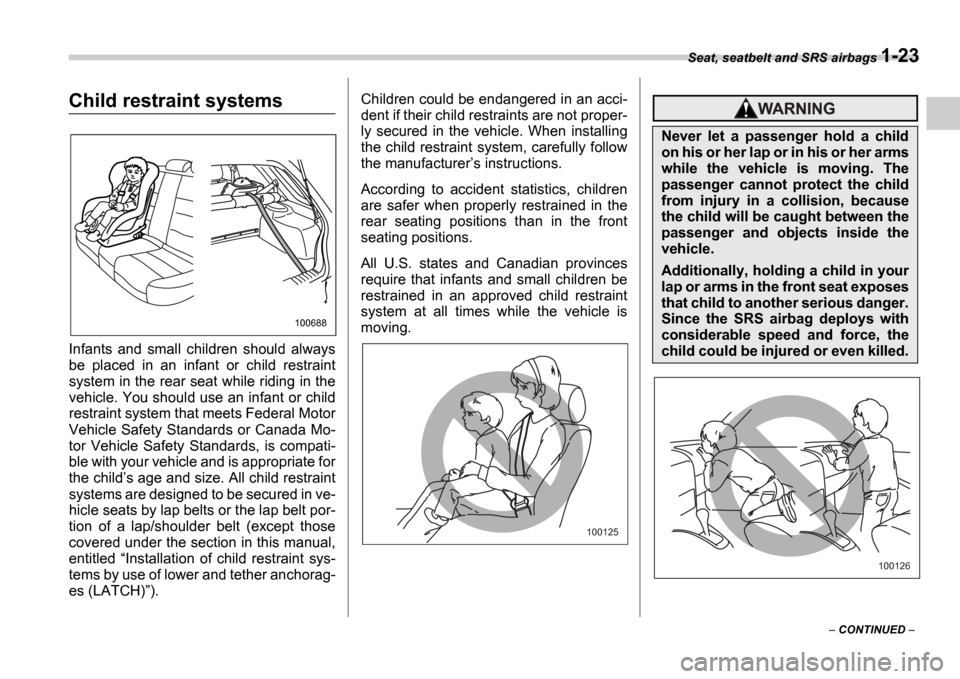
Seat, seatbelt and SRS airbags 1-23
CONTINUED
Child restraint systems
Infants and small children should always
be placed in an infant or child restraint
system in the rear seat while riding in the
vehicle. You should use an infant or child
restraint system that meets Federal Motor
Vehicle Safety Standards or Canada Mo-
tor Vehicle Safety Standards, is compati-
ble with your vehicle and is appropriate for
the childs age and size. All child restraint
systems are designed to be secured in ve-
hicle seats by lap belts or the lap belt por-
tion of a lap/shoulder belt (except those
covered under the section in this manual,
entitled Installation of child restraint sys-
tems by use of lower and tether anchorag-
es (LATCH) ). Children could be endangered in an acci-
dent if their child restraints are not proper-
ly secured in the vehicle. When installing
the child restraint system, carefully follow
the manufacturer
s instructions.
According to accident statistics, children
are safer when properly restrained in the
rear seating positions than in the front
seating positions.
All U.S. states and Canadian provinces
require that infants and small children be
restrained in an approved child restraint
system at all times while the vehicle is
moving.
100688
100125
Never let a passenger hold a child
on his or her lap or in his or her arms
while the vehicle is moving. The
passenger cannot protect the child
from injury in a collision, because
the child will be caught between the
passenger and objects inside the
vehicle.
Additionally, holding a child in your
lap or arms in the front seat exposes
that child to another serious danger.
Since the SRS airbag deploys with
considerable speed and force, the
child could be injured or even killed.
100126
Page 52 of 365
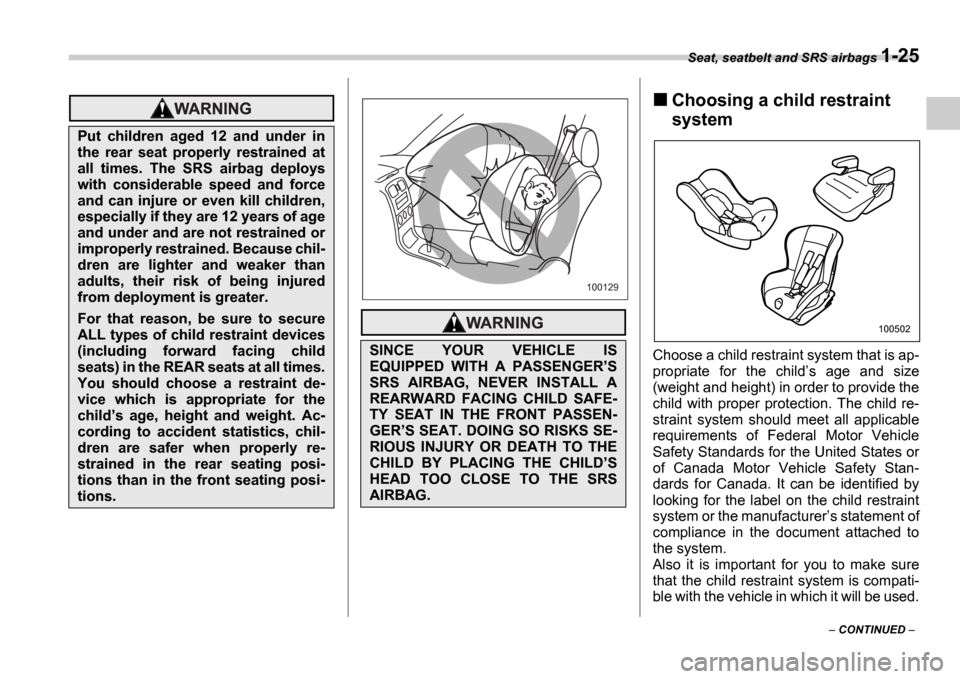
Seat, seatbelt and SRS airbags 1-25
CONTINUED
Choosing a child restraint
system
Choose a child restraint system that is ap-
propriate for the child s age and size
(weight and height) in order to provide the
child with proper protection. The child re-
straint system should meet all applicable
requirements of Federal Motor Vehicle
Safety Standards for the United States or
of Canada Motor Vehicle Safety Stan-
dards for Canada. It can be identified by
looking for the label on the child restraint
system or the manufacturer s statement of
compliance in the document attached to
the system.
Also it is important for you to make sure
that the child restraint system is compati-
ble with the vehicle in which it will be used.
Put children aged 12 and under in
the rear seat properly restrained at
all times. The SRS airbag deploys
with considerable speed and force
and can injure or even kill children,
especially if they are 12 years of age
and under and are not restrained or
improperly restrained. Because chil-
dren are lighter and weaker than
adults, their risk of being injured
from deployment is greater.
For that reason, be sure to secure
ALL types of child restraint devices
(including forward facing child
seats) in the REAR seats at all times.
You should choose a restraint de-
vice which is appropriate for the
child s age, height and weight. Ac-
cording to accident statistics, chil-
dren are safer when properly re-
strained in the rear seating posi-
tions than in the front seating posi-
tions.
SINCE YOUR VEHICLE IS
EQUIPPED WITH A PASSENGER S
SRS AIRBAG, NEVER INSTALL A
REARWARD FACING CHILD SAFE-
TY SEAT IN THE FRONT PASSEN-
GER S SEAT. DOING SO RISKS SE-
RIOUS INJURY OR DEATH TO THE
CHILD BY PLACING THE CHILD S
HEAD TOO CLOSE TO THE SRS
AIRBAG.
100129
100502
Page 64 of 365
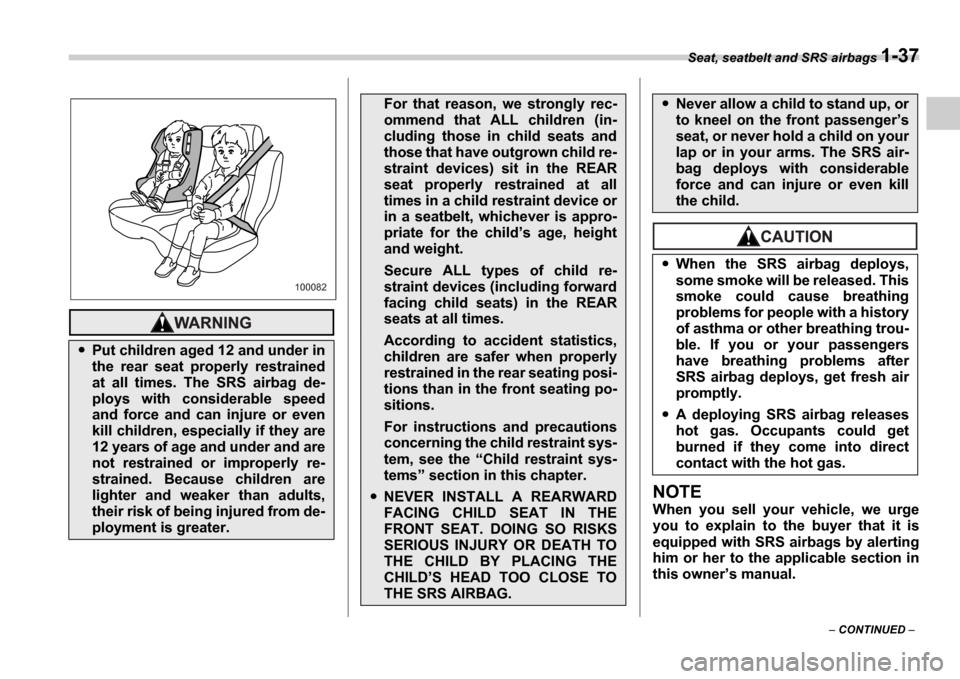
Seat, seatbelt and SRS airbags 1-37
CONTINUED
NOTE
When you sell your vehicle, we urge
you to explain to the buyer that it is
equipped with SRS airbags by alerting
him or her to the applicable section in
this owners manual.
Put children aged 12 and under in
the rear seat properly restrained
at all times. The SRS airbag de-
ploys with considerable speed
and force and can injure or even
kill children, especially if they are
12 years of age and under and are
not restrained or improperly re-
strained. Because children are
lighter and weaker than adults,
their risk of being injured from de-
ployment is greater.
100082
For that reason, we strongly rec-
ommend that ALL children (in-
cluding those in child seats and
those that have outgrown child re-
straint devices) sit in the REAR
seat properly restrained at all
times in a child restraint device or
in a seatbelt, whichever is appro-
priate for the child s age, height
and weight.
Secure ALL types of child re-
straint devices (including forward
facing child seats) in the REAR
seats at all times.
According to accident statistics,
children are safer when properly
restrained in the rear seating posi-
tions than in the front seating po-
sitions.
For instructions and precautions
concerning the child restraint sys-
tem, see the Child restraint sys-
tems section in this chapter.
NEVER INSTALL A REARWARD
FACING CHILD SEAT IN THE
FRONT SEAT. DOING SO RISKS
SERIOUS INJURY OR DEATH TO
THE CHILD BY PLACING THE
CHILD S HEAD TOO CLOSE TO
THE SRS AIRBAG.
Never allow a child to stand up, or
to kneel on the front passenger s
seat, or never hold a child on your
lap or in your arms. The SRS air-
bag deploys with considerable
force and can injure or even kill
the child.
When the SRS airbag deploys,
some smoke will be released. This
smoke could cause breathing
problems for people with a history
of asthma or other breathing trou-
ble. If you or your passengers
have breathing problems after
SRS airbag deploys, get fresh air
promptly.
A deploying SRS airbag releases
hot gas. Occupants could get
burned if they come into direct
contact with the hot gas.